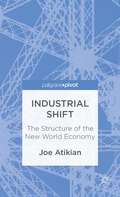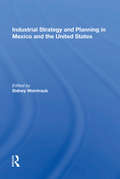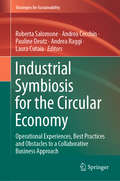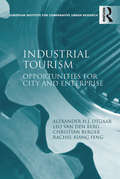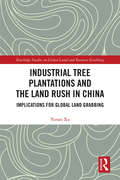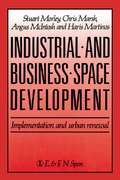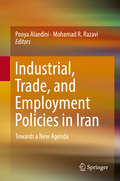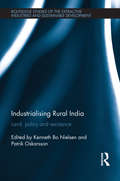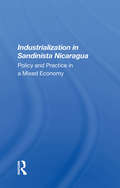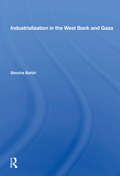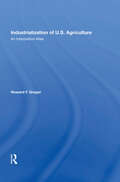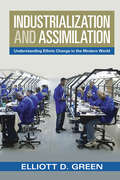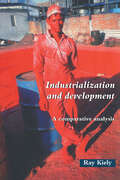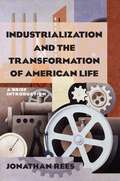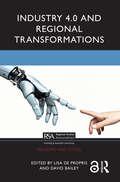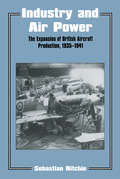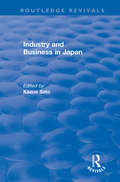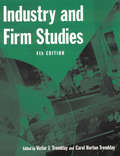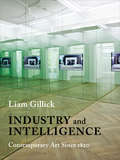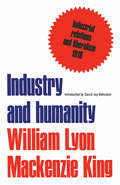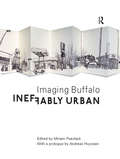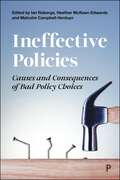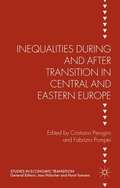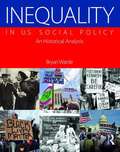- Table View
- List View
Industrial Shift: The Structure of the New World Economy
by Joe AtikianThis unique macro level analysis of the world's industrial structure reveals that ongoing advances in agriculture and manufacturing underpin the majority of growing economies.
Industrial Strategy And Planning In Mexico And The United States
by Sidney WeintraubThe role of industrial planning in trade is one of the most important areas of dispute between Mexico and the United States. The official U.S. stance stresses the dominance of the marketplace, while official Mexican industrial policy demands a large and active government role. Although the United States espouses free trade in theory, in practice it
Industrial Symbiosis for the Circular Economy: Operational Experiences, Best Practices and Obstacles to a Collaborative Business Approach (Strategies for Sustainability)
by Roberta Salomone Andrea Raggi Andrea Cecchin Pauline Deutz Laura CutaiaThe book is designed to help public and private decision-makers and academics deepen their knowledge and understanding of the contexts, obstacles and challenges of a variety of business types involved in Industrial Symbiosis and Circular Economy practices.Industrial Symbiosis is reported in the Action Plan on the Circular Economy developed by the European Commission in 2015 (COM / 2015/0614 final) and in its revision of 14 March 2017, but relatively little is known of how these practices start, develop or fail, and mutate in a rapidly changing context.Including selected contributions presented at the 24th ISDRS 2018 Conference, “Actions for a Sustainable World: from theory to practice” in the two theme tracks “5c. Circular economy, zero waste & innovation” and “5g. Industrial symbiosis, networking and cooperation as part of industrial ecology”, this book offers a transdisciplinary perspective on real experiences of industrial symbiosis, performed both by industries and the scientific community, best practices, success and unsuccessful cases (implemented or under implementation), with the final aim to promote the adoption of Industrial Symbiosis as an operational and systematic tool for the Circular Economy. In particular, a focus on the environmental, social, and economic impact of Circular Economy and Industrial Symbiosis practices, and how those impacts may be context and/or scale dependent is given.
Industrial Tourism: Opportunities for City and Enterprise (Euricur Series (european Institute For Comparative Urban Research) Ser.)
by Leo van Berg Alexander H.J. Otgaar Rachel Xiang FengIndustrial tourism presents opportunities, both in terms of income and as a tool of management, for individual firms who open their doors - and consequently their local regions - to the public. But how can these opportunities be organised in a way that enables both the city and the enterprise to take advantage? This book analyzes the conditions for successful industrial tourism development using case studies of Wolfsburg, Cologne, Pays de la Loire, Turin, Shanghai and Rotterdam, and makes astute recommendations for cities and companies with ambitions in this field.
Industrial Tree Plantations and the Land Rush in China: Implications for Global Land Grabbing (Routledge Studies in Global Land and Resource Grabbing)
by Yunan XuThis book analyses the political and economic causes, mechanisms and impacts of the industrial tree plantation boom in China. In the past two decades, the industrial tree plantation sector has been expanding rapidly in China, especially in Guangxi Province. Based on extensive primary data, this book concentrates on the political economy of the sector’s expansion with a focus on the recent and dramatic agrarian transformation involving the land-labour nexus, the impact on villagers’ livelihoods, the role of the state, and political reactions from below. The book questions the stereotypical portrayal of local communities as the excluded villager. Instead, it demonstrates that this is a much more complex issue with varying levels of passive and active forms of inclusion and exclusion within local communities. While most literature focuses on crop booms for food and biofuel production the industrial plantation sector has largely been overlooked, despite it being one of the biggest sectors in the current rush for land. Filling this lacuna, this book also reveals that while China has traditionally been painted as a major land grabber and consumer of crop booms it is also a destination of foreign investment. In doing so the book highlights how large-scale foreign land deals can also take place in traditional ‘grabber’ countries like China which feeds into the wider debates about global land politics and resource grabbing. This book will be of great interest to students and scholars of land grabbing, rural development and agrarian transformations, as well as Chinese development.
Industrial and Business Space Development: Implementation and urban renewal
by C. Marsh H. Martinos A. McIntosh S. MorelyAn insight into the changing nature of the industrial and business space property market and how business space development schemes can be initiated and implemented to revitalise urban areas.
Industrial, Trade, and Employment Policies in Iran: Towards a New Agenda
by Pooya Alaedini Mohamad R. RazaviThis volume explores Iran’s industrial and trade policy options for achieving sustainable, export-oriented, and pro-employment growth. The first part of the book discusses Iran’s economic and industrial development performance, as well as strategies for enhancing capabilities, fostering productive transformation, and developing employment that can result in faster and more inclusive economic growth. It also presents a case study on a leading manufacturing subsector—the automotive industry. The book then offers a set of analyses concerning the country’s trade sector, including exchange rate policies, ways to connect to global markets, and accession to the World Trade Organization. In turn, the closing chapters investigate various aspects of Iran’s labor market and offer policy recommendations on the creation of productive jobs. Readers will learn about effective industrial, trade, and employment policies that can complement macroeconomic measures adopted by the government. As such, the book will appeal not only to scholars and policy-makers, but also to international investors seeking to understand various core aspects of Iran’s industrial and employment structures and trade regime.
Industrialising Rural India: Land, policy and resistance (Routledge Studies of the Extractive Industries and Sustainable Development)
by Kenneth Bo Nielsen Patrik OskarssonRapid industrialisation is promoted by many as the most feasible way of rejuvenating the Indian economy, and as a way of generating employment on a large scale. At the same time, the transfer of land from rural communities and indigenous groups for industrial parks, mining, or Special Economic Zones has emerged as perhaps the most explosive issue in India over the past decade. Industrialising Rural India sheds light on crucial political and social dynamics that unfold today as India seeks to accelerate industrial growth. The volume examines key aspects that are implicated in current processes of industrialisation in rural India, including the evolution of industrial and related policies; the contested role of land transfers, dispossession, and the destruction of the natural resource base more generally; and the popular resistance against industrial projects, extractive industries and Special Economic Zones. Combining the work of scholars long established in their respective fields with the refreshing approach of younger scholars, Industrialising Rural India seeks to chart new ways in the study of contemporary industrialisation and its associated challenges in India. This cutting-edge interdisciplinary work will be of interest to scholars working on industrial development and land questions in India and South Asia alongside those with an interest in sociology , political science and development research.
Industrialization In Sandinista Nicaragua: Policy And Practice In A Mixed Economy
by Andrew ZimbalistThis book explores whether the Sandinista 'mixed economy'—a 'transitional' mixed economy—could have been stable if the Sandinistas had been able to pursue their industrialization strategy for a longer period of time. It explains why Nicaragua's mixed economy was stable for almost eleven years.
Industrialization In The West Bank And Gaza
by Simcha BahiriThe West Bank and Gaza Strip, occupied by Israel since 1967, have stagnated in the number employed (some 17,000) in domestic industry for 20 years and in the percentage contribution (8.5 per cent) to the gross domestic product. Their 4,000 establishments are mostly workshops employing on average just over four workers. Food and textiles are the dominant industries and there is much sub-contracting for Israeli firms. Some 90 per cent of industrial imports come from or through Israel and some 70 per cent of their industrial exports go to Israel, with the remainder going to or through Jordan. There are many barriers to the development of industry in the occupied territories but they overwhelmingly have their origin in the occupation itself and to a lesser degree result from difficulties made by Jordan. The Military Government runs the territories to ensure not only military security but also Israel's "economic security." Three alternative economic scenarios are projected to 1997 based on three possible futures facing the territories: (a) a conservative scenario based on continuing the occupation in its present form (status quo); (b) a reformist scenario in which both Israel and Jordan liberalize their policies within the framework of continued occupation; and (c) a radical scenario in which Israel leaves the territories in return for peace, and a separate Palestinian entity is established. In terms of industrial development the conservative scenario would yield minimal results, the reformist scenario some minor improvements in the "quality of life," and the radical scenario would result in rapid industrial development and settlement of returning refugees.
Industrialization Of U.S. Agriculture: An Interpretive Atlas
by Howard F GregorOriginally published in 1986, this volume explores capitalization as an industrialisation indicator and the scale of capitalization in the areas of labor, cropping and in livestock and poultry. Finally the performance of agricultural industrialisation is discussed. This book offers a geographic view of what many consider the ultimate revolution in American agriculture: industrialization. The major technological advances and production increases associated with the process have become a significant event in world agricultural history, and for a long time the great majority of Americans accepted them as natural outcomes of economic and even cultural goals. But for the past thirty to forty years agricultural industrialization has proceeded from "a brisk walk to a dash," and the increased pressure on smaller farmers and farm-workers, as well as on natural resources, has become serious enough to evoke demands from many quarters for regulatory action. Yet compared to the magnitude of the event and the increasing concern, much is still unknown about its regional character and extent.
Industrialization and Assimilation: Understanding Ethnic Change in the Modern World
by Elliott D. GreenIndustrialization and Assimilation examines the process of ethnic identity change in a broad historical context. Green explains how and why ethnicity changes across time, showing that, by altering the basis of economic production from land to labour and removing people from the 'idiocy of rural life', industrialization makes societies more ethnically homogenous. More specifically, the author argues that industrialization lowers the relative value of rural land, leading people to identify less with narrow rural identities in favour of broader identities that can aid them in navigating the formal urban economy. Using large-scale datasets that span the globe as well as detailed case studies ranging from mid-twentieth-century Turkey to contemporary Botswana, Somalia and Uganda, as well as evidence from Native Americans in the United States and the Māori in New Zealand, Industrialization and Assimilation provides a new framework to understand the origins of modern ethnic identities.
Industrialization and Development: An Introduction
by Ray KielyAn introductory development studies text which puts industrialization into theoretical context, examines the forms it has taken, and considers economically efficient and socially responsible alternatives.
Industrialization and the Transformation of American Life: A Brief Introduction
by Jonathan ReesThis book provides a descriptive, episodic yet analytical synthesis of industrialization in America. It integrates analysis of the profound economic and social changes taking place during the period between 1877 and the start of the Great Depression. The text is supported by 30 case studies to illustrate the underlying principles of industrialization that cumulatively convey a comprehensive understanding of the era.
Industry 4.0 and Regional Transformations (Regions and Cities)
by David Bailey Lisa De ProprisThis edited volume brings together a group of expert contributors to explorebthe opportunities and the challenges that Industry 4.0 (smart manufacturing) is likely to pose for regions, fi rms and jobs in Europe. Drawing on theory and empirical cases, it considers emerging issues like servitization, new innovation models for local production systems and the increase in reshoring. Industry 4.0 and Regional Transformations captures the complexity of this new manufacturing model in an accessible way and considers its implications for the future. It will be essential reading for advanced students and researchers and policy makers in regional studies, industrial policy, economic geography, innovation studies, operations management and engineering.
Industry and Air Power: The Expansion of British Aircraft Production, 1935-1941 (Studies in Air Power #Vol. 5)
by Sebastian Ritchie Noel Sebastian RitchieThe author begins with a general survey of British aircraft manufacturing in the inter-war period. Policy, production, finance and contracts are examined, and the final chapter is concerned with the mobilization of the aircraft industry in 1939, and the emergency measures of 1940.
Industry and Bus in Japan (Routledge Revivals)
by Kazuo SatoThis title was first published in 1980: This volume analyzes Japan's industrial organization both from a historical perspective and by looking in details at specific industries such as iron, steel and the automotive industry. Big business, business groups and industrial policy are also discussed. The volume also provides a survey of the literature in Japanese which will help the reader in search of original sources.
Industry and Firm Studies
by Victor J. Tremblay Carol Horton TremblayThe fourth edition of this acclaimed text is a rich resource for undergraduate and graduate courses in industrial organization, applied game theory, and management strategy. It incorporates game theory into industry analysis by studying the behavior of successful and failing firms as well as the structure-conduct-performance of particular industries. Chapters address a wide variety of issues concerning industry structure, policy towards business, and the strategic innovations and blunders of individual firms. New coverage of professional sports, soft drinks, distilled spirits, and cigarettes complements revised and updated chapters on airline services, retail and commercial banking, health insurance, motion pictures, and brewing. The book includes firm case studies of General Motors, Microsoft, Schlitz, and TiVo.
Industry and Intelligence: Contemporary Art Since 1820 (Bampton Lectures in America)
by Liam GillickThe history of modern art is often told through aesthetic breakthroughs that sync well with cultural and political change. From Courbet to Picasso, from Malevich to Warhol, it is accepted that art tracks the disruptions of industrialization, fascism, revolution, and war. Yet filtering the history of modern art only through catastrophic events cannot account for the subtle developments that lead to the profound confusion at the heart of contemporary art.In Industry and Intelligence, the artist Liam Gillick writes a nuanced genealogy to help us appreciate contemporary art's engagement with history even when it seems apathetic or blind to current events. Taking a broad view of artistic creation from 1820 to today, Gillick follows the response of artists to incremental developments in science, politics, and technology. The great innovations and dislocations of the nineteenth and twentieth centuries have their place in this timeline, but their traces are alternately amplified and diminished as Gillick moves through artistic reactions to liberalism, mass manufacturing, psychology, nuclear physics, automobiles, and a host of other advances. He intimately ties the origins of contemporary art to the social and technological adjustments of modern life, which artists struggled to incorporate truthfully into their works.
Industry and humanity: A study in the principles of industrial reconstruction
by David Bercuson William KingIndustry and Humanity was first published in 1918. In it William Lyon Mackenzie King, then a prominent public servant who had forged a respectable reputation among business leaders as an expert in labour affairs, discussed the process of national and industrial reconstruction then about to begin. The book reviewed several momentous crises in North American labour-management relations, revealed the background to various important pieces of Canadian legislation in the field of social welfare, and provided a broad rationale for the establishment of a new programme of democracy in industry. Industry and Humanity is not only a history of King's career as industrial relations expert and consultant for the Canadian government and several giant American corporations. It also contains illustrations and analogies from his urban industrial and educational experiences. He did settlement work, examined working conditions and trade unionism in his graduate studies at university, and pioneered in the federal department of labour in examining at close hand some of the most undesirable effects of industrialization. The portions of the book which were derived from King's experiences in investigation and arbitration work present an invaluable picture of deplorable working conditions and wasting away of human lives. King's analysis of strikes – their causes and social consequences – is the book's central theme and is an accurate and telling assessment of the effects of social strife on the well-being of the community. Moreover, King put flesh on the dry statistics of industrial accidents and illnesses and the testimony of countless inquiries and royal commissions with vivid descriptions of the dehumanizing effects of the modern factory system.
Ineffably Urban: Imaging Buffalo
by Miriam PaeslackBuffalo, in New York state, is 'ineffable': a typical city in transition between its past and future. It is a classic example of one of many 'shrinking cities' in North America and elsewhere which once prospered because of heavy industrialization, but which now have to deal with various degrees of urban decay. Bringing together a range of scholars from the humanities, the social sciences, art and architecture, this volume looks at both the literal city image and urban representation generated by photographs, video, historical and contemporary narratives, and grass-root initiatives. It investigates the notion of agency of media in the city and, in return, what the city’s agency is. This agency matters particularly as it is both transforming - shrinking, fading, being redefined - and being shaped through its visual and spatial mediation. While illustrated by Buffalo in particular, the book examines a broader phenomenon: the identity of those cities that were built and blossomed during the late 19th and early 20th century and are now in different stages of decline and disintegration. However, while such cities are all confronted with complex issues of economic instability, social and racial segregation, urban sprawl and shrinking processes both in the inner city and more and more in their ex-urban belts, they are too often described through dramatically simplifying visual and linguistic tropes. In Buffalo such tropes refer dialectically either to the city’s past glory or its presumed current cultural, political and economical stasis and decline. This book takes such tired, and familiar tropes and questions them.
Ineffective Policies: Causes and Consequences of Bad Policy Choices
by Ian Roberge, Heather McKeen-Edwards, and Malcolm Campbell-VerduynAvailable open access digitally under CC-BY-NC-ND licence. Bad policies have repercussions that can be felt for decades. But what makes a bad policy? And how can it be reversed or improved? Bringing together scholars from Europe and North America, this book goes beyond traditional policy theory to study bad and ineffective policies across three fields: • the environment; • the financial services sector; and • emerging technologies. Using cutting-edge research and analysis, the editors and authors state the case for studying ineffective policies, demonstrate their harmful effects across policy fields and provide policy makers with the tools to reflect, identify, and act upon them.
Inequalities During and After Transition in Central and Eastern Europe
by Cristiano Perugini Fabrizio PompeiThe book deals with the key aspects of social and economic inequalities developed during the transition of the formerly planned European economies. Particular emphasis is given to the latest years available in order to consider the effects of the global crisis started in 2008-2009.
Inequality In Labor Market Areas
by Joachim SingelmannDuring the past two decades, many attempts have been made to refocus stratification research and the study of inequality. The contributors to this volume have a long-term concern with the importance of space and locality. Many of them belonged to a research project during the early 1980s that had as one of its main aims the analysis of labor force
Inequality In US Social Policy: An Historic Analysis
by Bryan WardeIn Inequality in US Social Policy: An Historic Analysis, Bryan Warde illuminates the pervasive and powerful role that social inequality based on race and ethnicity, gender, immigration status, sexual orientation, class, and disability plays and has historically played in informing social policy. Using critical race theory and other structural oppression theoretical frameworks, this book examines social inequalities as they relate to social welfare, education, housing, employment, health care, and child welfare, immigration, and criminal justice. This book will help social work students better understand the origins of inequalities that their clients face.
